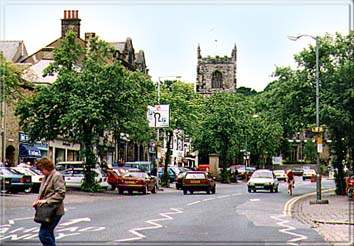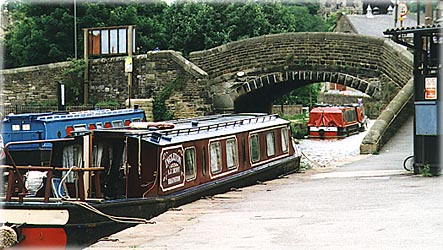Skipton
The Gateway to the Dales
The busy town of Skipton, positioned in the Aire Gap, the entrance to the ancient routeway across the Pennines, is an excellent centre for exploring the Southern Dales. There is a long history of settlement here, and the town has seen many peoples come and go. The Mesolithic hunters, the Bronze Age traders and the ancient British tribe of the Brigantes all inhabited the area in their turn, but it was the later Angles, Danes and Norsemen who cleared the area of its forest and made the first villages. Skipton itself was a small village in Anglian times, probably named ‘Scepton’ (Sheep town).
The town began to prosper and grow during Norman times when Robert de Romille, one of the Norman barons, was granted the Manor of Skipton by The Conqueror. He chose the most defensive site he could find for Skipton Castle, abandoning the Saxon manor house that the Earl Edwin had used for his headquarters. All that remains of this C11th castle is one of the gateways, while the rest of the present building dates from the C14th when it was rebuilt by Robert de Clifford. The castle had an eventful history after its rebuilding, including a period as a Yorkshire stronghold of the Lancastrians in the mid-C15th. In 1536 it successfully resisted siege, and in the late C16th remained loyal to Queen Elizabeth during the ‘Rising of the North’. In 1642 it was besieged by Cromwell’s forces, and although it was defended for 3 years by Sir John Mallory and 300 troops, it was at last forced to surrender in December 1645. The Parliamentarians severely damaged the castle, but the energetic Lady Anne Clifford made extensive repairs, and today the castle is one of the most well preserved in the country. It is open to the public, and among its many interesting features is the lovely Conduit Courtyard with its ancient yew tree (planted in 1659 by Lady Anne) and a room in classic style, most unusually decorated in mother pearl. A favourite with the children is the medieval toilet, the waste of which falls many feet into the moat! The Clifford family motto can be seen above the gatehouse, 'Desormais'- Henceforth.

View down the High Street
The town grew up to provide for the needs of the castle and, in 1203, a Charter was granted for markets and fairs. Although never large, the settlement grew steadily until in 1340 the Black Death claimed half the population. It eventually recovered from the disaster and reached a peak of prosperity in the C19th as the importance and convenience of its position in the Airedale gap was recognised and exploited.
Skipton is still a bustling and thriving market and tourist centre, and there is much of interest to see in the town as well as in the surrounding area. At the top of the High Street, next to the castle, is the Parish Church (Holy Trinity.) This is a largely C14th-C16th construction, although the site as been a place of worship since at least 1120, with extensive C17th repair work done at the expense of Lady Anne Clifford after great damage was sustained in the Civil War. Of particular interest inside the church are the C16th rood screen and the C14th font, as well as some fine Clifford family tombs. Ancestors of the American poet Longfellow are also resting here.
Sheep Street contains some of the towns oldest buildings, including several charming houses and a toll booth. The former Town Hall was here with the prison cells underneath. In 1820 the local policeman, Tom Lowcock, thought the cells unfit for use, and if he had a prisoner he would take him home at night and handcuff him to his oven door! The town stocks are still in place. Other places of interest are the Craven Museum in the Town Hall, Friends Meeting House built in 1693, and C16th Grammar School.
The Castle
The town has its own newspaper the Craven Herald, believed to be one of only two such newspapers with the front page dedicated to small advertisements with no news whatsoever. Many shops, cafes and pubs line both sides of the street, but you won't find a Marks and Spencers store in town which is a surprise considering the co-founder Thomas Spencer was born here in 1851. An open air market is held four days a week. Craven Court is a Victorian style shopping area. Fattorini's (The Jewellers) had their first shop in the town. Fattorini's (Bradford) made the F.A.Cup, which was immediately won by Bradford City AFC in 1911. A member of the family, Tom Fattorini, owns Skipton Castle today. I'd better not forget my mother-in-law, she was born at Water Street, aeons ago......only joking!

The Canal
The Leeds-Liverpool Canal, 127 miles long, and the longest single canal in the country, winds its way through the town. Nearby tourist attractions to Skipton are The Embsay Steam Railway, Bolton Abbey and of course many charming dales villages.
I first fell in love with Skipton in my late teens, when I and a few mates would go for a 'nash' on our motorbikes. You will still see many motorcyclists there on Sundays, and, if the weather is fine I could be amongst them!